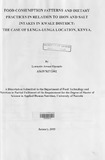Food consumption patterns and dietary practices in relation to iron and salt intakes in Kwale District: The case of Lunga-Lunga Location, Kenya

View/
Date
2005Author
Opondo, Lynnette A
Type
ThesisLanguage
enMetadata
Show full item recordAbstract
A cross-sectional and descriptive study was carried out in Lunga-Lunga location in Kwale
District in March 2004 for a period 'of three weeks to determine the food consumption patterns
and the dietary practices in relation to salt and iron intakes. The study comprised 30 households
and involved the measuring of the food intakes of the study population for three days to establish
their dietary patterns. Data on demography was collected by use of a structured questionnaire.
Anthropometric measurements were taken for all household members who were present during
meal times. F.ocus group discussions were conducted with mothers who did not participate in the
study as well as women above childbearing age. In-depth interviews were also conducted as well
as observations to obtain information on the dietary patterns and practices in the study area.
The dietary patterns indicate that the foods consumed by the households contained sufficient
amounts of iron but most of it was non-haem iron and only 4.85% of the iron consumed was
bioavailable for utilisation by the body. As a result, 83.9% of the respondents did not meet their
iron nutrient adequacy levels. The foods consumed contained iron inhibitors such as phytates
with a mean phytate content of 15.44 ± 12.45 mg. Vitamin C that is an enhancer for the
absorption of iron was also deficient in 60% of the households.
The diets were not varied and were insufficient in calories. Protein adequacy was met by 95.5%
of the households but since the diets were deficient in supplying the energy requirements the
proteins may be converted to calories to meet the energy needs of the individuals. Salt was
consumed daily by all the households and the mean daily intake was 4.36 ± 2.54 gms for
children aged one to eleven years, to 10.29 ± 4.41 gms for adults. The results also showed that
food avoidance taboos that affect food consumption mostly focus on expectant mothers. These
taboos prohibit them from eating mostly fish and eggs that are good sources of iron during
pregnancy.
The findings indicate that 17.4%of the under fives were wasted, when compared to the standard.
The cases of underweight children were 21.7% while those who suffered from chronic
malnutrition (stunting) were 30.4%. Among the 6-11 year olds, 17.4% were wasted,
21.7%und~eight and 29.4% stunted. The BMI indicates that 46.5% of the adults were
underweight.
The findings of the study indicate that the anaemia experienced in Kwale District may not be due
to inadequate dietary iron, but other factors such as bioavailability of the iron consumed, the high
level of phytates in the diet. Parasitic infestations e.g. malaria, hookworms and filiriasis which
are common in the area could also be contributing factors.
Citation
Degree of Master of Science in Applied Human Nutrition, University of NairobiPublisher
University of Nairobi Department of Food Technology and Nutrition
Description
A Dissertation Submitted to the Department of Food Technology and
Nutrition in Partial Fulfilment of the Requirement for the Degree of Master of
Science in Applied Human Nutrition, University of Nairobi
